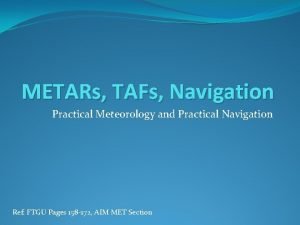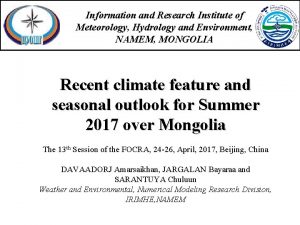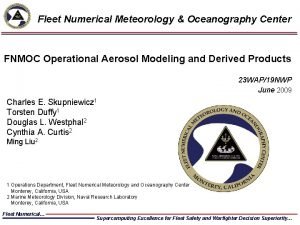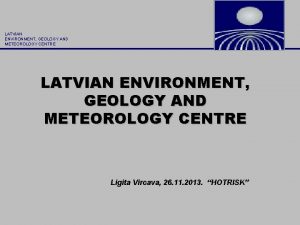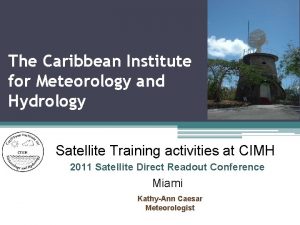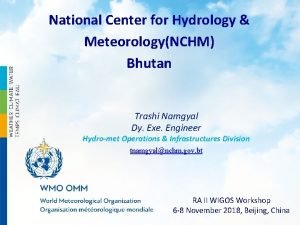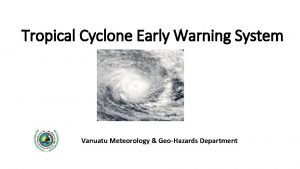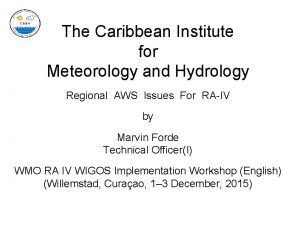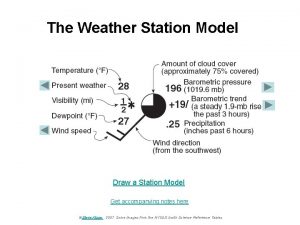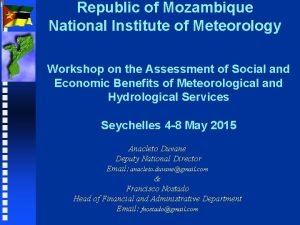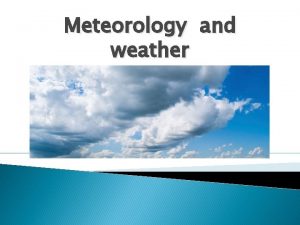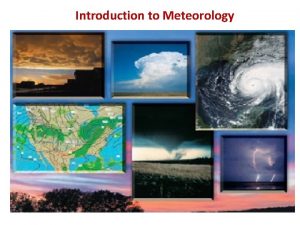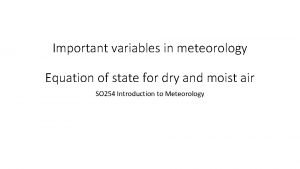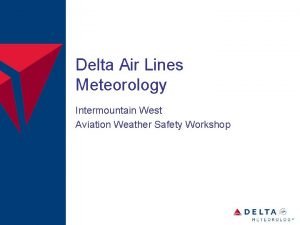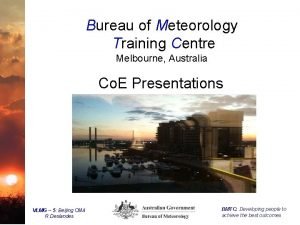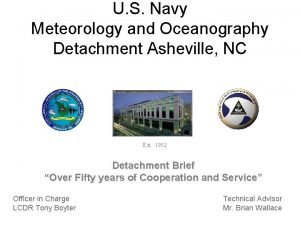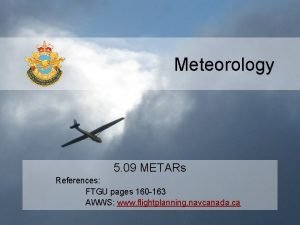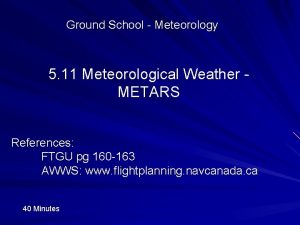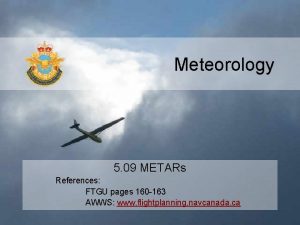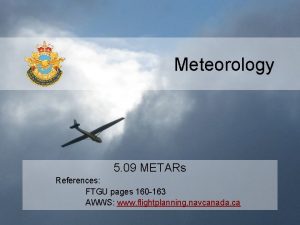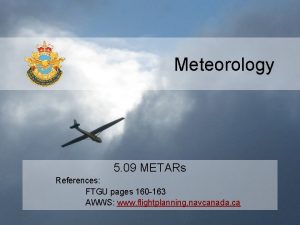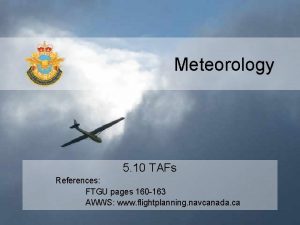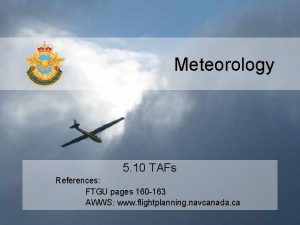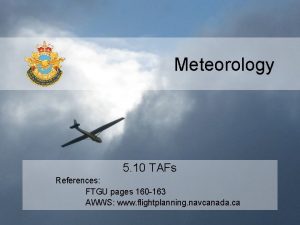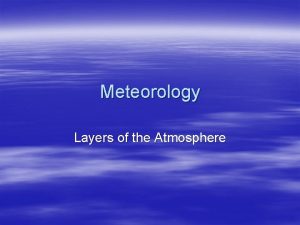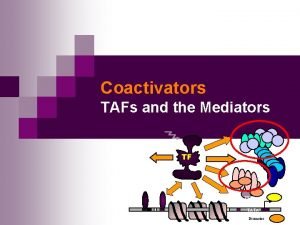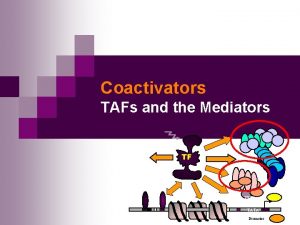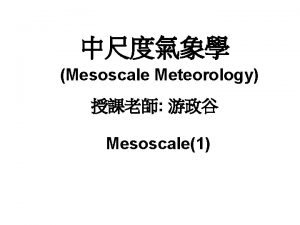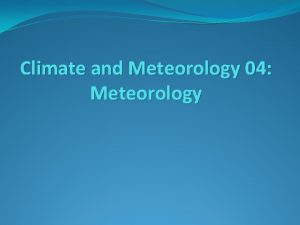METARs TAFs Navigation Practical Meteorology and Practical Navigation




















- Slides: 20

METARs, TAFs, Navigation Practical Meteorology and Practical Navigation Ref: FTGU Pages 158 -172, AIM MET Section

Review 1. What are the four air masses that affect Canada? 2. What is a Front? 3. What does a thunderstorm need in order to form?

Topics to be covered �Weather services and maps �How to read: �METARs/TAFs �Need to know this as interpretation of weather is crucial to aircraft safety.

METeorological Aviation Reports (METARs)

METARs �Aviation Routine Weather Report �Observation of the actual weather from the ground �Issued on the hour and valid only for the time taken �A SPECI is a special weather report that when a significant change in the weather has occurred �Each METAR and SPECI is composed of several standard groups �METAR CYKZ 202000 Z 33009 KT 15 SM FEW 020 BKN 091 M 01/M 06 A 2993 RMK SC 2 AC 3 SLP 144=

Format of METAR �Report type: �Location type: �Date/Time: �Report modifier: �Wind: �Visibility: �RVR: METAR or SPECI CYYZ (Toronto) 231700 Z -> 23 rd day at 1700 Zulu AUTO or CCA, CCB 00000 KT -> Calm 35009 KT -> 350°T @ 9 kts VRB 03 KT -> Variable @ 3 kts 30015 G 25 KT -> 300°T @ 15 gusting 25 kts 30015 G 25 KT 260 V 340 -> 300°T @ 15 gusting 25 kts, wind is varying from 260 true to 340 true 5/8 SM, 1 ½ SM, P 6 SM, 15 SM R 33/4000 FT/U -> Rwy 33, 4000’ increasing R 24 L/1000 V 1200 FT/D -> ?

Present Weather Codes Intensity or Proximity Descriptor �Precipitation intensity refers to all forms at the time combined �- ->Light (-RA = Light rain) �Moderate (no qualifier) �+ Heavy (+SN = Heavy snow) �VC = In the vicinity (within 5 SM) �MI = Shallow �BC = Patches �PR = Partial �DR = Drifting �BL = Blowing �SH = Showers �TS = Thunderstorms �FZ = Freezing

Present Weather Codes Precipitation Obscuration � DZ � RA � SN � SG � IC �BR = Mist (Vis ≥ 5/8 SM) �FG = Fog (Vis < 5/8 SM) �FU = Smoke (Vis ≤ 6 SM) �DU = Dust (Vis ≤ 6 SM) �SA = Sand (Vis ≤ 6 SM) �HZ = Haze (Vis ≤ 6 SM) �VA = Volcanic ash (Any vis) � PL � GR � GS � UP = Drizzle = Rain = Snow grains = Ice crystals (Vis ≤ 6 SM) = Ice pellets = Hail = Snow pellets = Unknown precipitation

Present Weather Codes Other �PO = Dust/sand whirls (dust devils) �SQ = Squalls �+FC = Tornado or waterspout �FC = Funnel cloud �SS = Sandstorm �DS = Duststorm

Sky Condition �SKC �FEW �SCT �BKN �OVC �CLR - “sky clear” - no cloud present - “few” - >0 to 2/8 oktas - “scattered” - 3/8 to 4/8 oktas - “broken” - 5/8 to <8/8 oktas - “overcast” - 8/8 oktas - “clear” - clear below 10, 000’ as interpreted by an autostation �Significant convective cloud (CB or TCU) are identified with the sky condition group SCT 025 TCU – Scattered TCUs at 2500’ �A ceiling is said to exist at the lowest BKN or OVC layer �All cloud heights are in AGL

�Temperature/Dewpoint: 10/05 – Temp: 10°C, Dewpoint: 05°C 05/M 01 – Temp: 05°C, Dewpoint: -1°C �Altimeter setting: A 2992 – 29. 92” Hg A 3031 – 30. 31” Hg �Recent weather: Significant weather �Wind shear: Low level windshear within 1600’ AGL along t/o or landing path or a specific runway “WS R 33 L”

Remarks �Include: �Cloud layer type and opacity in oktas (SF 5) �General weather remarks �Sea level pressure: SLP 134 = 1013. 4 h. Pa �SPECI CYEL 201958 Z 36010 KT 1 SM -SHSN OVC 008 RMK SF 8 WNDS ESTD= �METAR CYEL 201900 Z 36010 KT 15 SM -SHSN BKN 030 BKN 080 M 05/M 10 A 3003 RMK SC 6 AC 2 WNDS ESTD SLP 190=

Terminal Area Forecasts (TAFs)

Aerodrome Forecast (TAF) �Description of the most probable weather conditions with the most probable time of occurrence �Gives weather within 5 NM of the centre of the runways complex �Uses the same weather coding as the METAR, although forecast times are included �Altitudes in AGL �Degrees are given in True

TAF Format �Report type: TAF or TAF AMD �Location: CYYZ �Issue Date/Time: 281139 Z: 28 th day @ 1139 Zulu �Period of validity: 2812/2918 – Valid from 1200 Zulu on the 28 th to 1800 Zulu on the 29 th �TAF CYYU 201948 Z 2020/2108 30012 KT 3 SM -SN OVC 012 TEMPO 2020/2022 P 6 SM SCT 015 BKN 030 FM 202200 30010 KT P 6 SM SCT 015 BKN 030 TEMPO 2022/2108 4 SM –SHSN BKN 015 RMK NXT FCST BY 210200 Z=

TAF Format – Significant Weather �Uses the same format as the METAR �VC or ‘vicinity’ in a TAF means 5 – 10 NM �A maximum of 3 significant weather groups are allowed per forecast period �If one significant weather groups is forecast to change, all other that will exist will be indicated �CB layers will be identified with cloud groups (i. e. SCT 040 CB)

Change Groups �In all change groups, multiple elements are considered single entities �“SCT 030 BKN 050 OVC 080. . . change indicator. . . BKN 050” would mean that after the change indicator, there would only be a broken layer at 5000’ �FM – Permanent change (rapid) – All forecast conditions are superseded by this. FM 280945 30015 KT P 6 SM BKN 030

Change Groups �BECMG – Permanent change (gradual) – When the conditions evolve over a period of time (one to two hours) BECMG 2808/2809 OVC 030 � Any weather element not indicated as part of the BECMG group remains the same �TEMPO – Transitory change group – Temporary fluctuations in some or all weather elements during a specified period �TEMPO are only used if the condition is expected to last less then an hour, if more, than a time period would be given (i. e. TEMPO 2812/2815 1 SM RA BR) �PROB – Probability group – Probability of alternative weather values occurring (that are considered hazards to aviation) -> PROB 30 2817/2821 +TSRA

�TAF CYTS 201948 Z 2020/2108 33012 KT 11/2 SM -SHSN OVC 015 TEMPO 2020/2022 P 6 SM NSW OVC 020 FM 202200 33012 KT 6 SM -SN FEW 015 OVC 040 TEMPO 2022/2102 2 SM –SN OVC 015 FM 210200 31010 KT P 6 SM SCT 020 BKN 030 TEMPO 2102/2108 4 SM -SHSN BKN 020 RMK NXT FCST BY 210200 Z= �TAF CYTL 201948 Z 2020/2108 33015 KT P 6 SM SCT 015 OVC 025 TEMPO 2020/2108 2 SM -SHSN BKN 015 OVC 030 BECMG 2102/2104 31012 KT RMK FCST BASED ON AUTO OBS. NXT FCST BY 210200 Z=

Summary �Topics covered today: �How to read: � METARs/TAFs �Next class will be Navigation
 Metars and tafs
Metars and tafs Tafs client portal
Tafs client portal Meteorology hydrology and water management
Meteorology hydrology and water management Fnmoc
Fnmoc Latvian environment, geology and meteorology centre
Latvian environment, geology and meteorology centre Caribbean weather satellite
Caribbean weather satellite National center for hydrology and meteorology
National center for hydrology and meteorology Vanuatu meteorology
Vanuatu meteorology Caribbean institute for meteorology and hydrology
Caribbean institute for meteorology and hydrology How to draw a weather station
How to draw a weather station Cisk meteorology
Cisk meteorology National institute of meteorology
National institute of meteorology Penn state meteorology certificate
Penn state meteorology certificate Study of weather
Study of weather Mesopause definition
Mesopause definition Equation of state for dry air
Equation of state for dry air Delta meteorology
Delta meteorology Graduate diploma in meteorology
Graduate diploma in meteorology Cin meteorology
Cin meteorology Weather model symbols
Weather model symbols Share data
Share data
